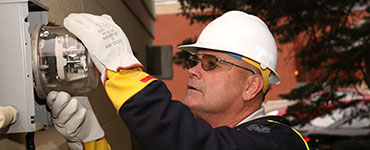Aging in place
Universal design considerations
As you’re planning your new home, consider how long you plan to live there. If it’s your “dream home,” it’ll probably be the last home you own – so it’s important to make it easy to live in for years to come.
By using "universal design" techniques, you can make your new house usable by every family member - regardless of age, size, abilities or disabilities – throughout their lives.
Universal design enables independent living with three basic features:
- Entrances with no steps: This makes it easier to enter the home, particularly in the dark.
- Wider doorways and hallways: With 32 inches of clearance, wider doors and halls allow easier access for wheelchairs.
- One accessible bathroom on the first floor: An easy-to-use bathroom will benefit everyone in the family.
These features are just the beginning – almost every element of a home can be designed or adjusted to accommodate special needs.
Outside the home
The use of “zero-clearance” entryways are a great safety features, especially during wet or icy weather. The absence of steps also means easier removal of snow, ice and leaves – and no repair and maintenance.
In an existing home, ramps can be installed over or around steps to allow for easier access.
Inside the home
Wider doorways and hallways not only improve accessibility, they also enhance circulation, add a more spacious feel and reduce bangs and bumps against door jambs.
Casement windows with easy-to-grab crank handles allow for easier opening than awkward sliding double-hung sashes.
Lower light switches and higher electrical outlets are a common element in “universal” homes. By installing switches several inches lower, people in wheelchairs can reach them without assistance – and higher outlets keep little fingers out of danger.
Instead of round knobs, door levers accommodate people with arthritis or other mobility problems – and children as well.
Remote-control ceiling fans and window coverings are other easy-to-install features. For even greater convenience, a home automation system can control everything from lighting to security alarms.
In the kitchen
Many unique features can be built into a kitchen for greater accessibility, including:
- Ovens at lower height and with side-opening doors;
- Elevated dishwashers;
- Sinks and cooktops that move up and down;
- Lower countertops with open space below;
- Full-extension drawers and shelves;
- Greater use of base cabinets; and
- Open shelving instead of wall cabinets.
In the bathroom
Grab bars near the toilet and in the shower are important safety features in an accessible home.
Single-lever faucets in the vanity sink, tub and shower are easier to operate and adjust, reducing the risk of dangerous scalding and messy splashing.
Zero-clearance showers allow wheelchairs to roll right in, and built-in seating makes bathing safer and more comfortable.
The costs
Implementing universal design features may add 10 percent to the overall cost of building your new home, depending on the modifications you choose.
But keep in mind that spending a little extra money now is a great investment in your future – you’ll be able to live and maintain your own home for years instead of worrying about safety and repairs as you get older.
By planning ahead, you can build an affordable, accessible home – talk to your contractor today!
More from this category
Historic preservation
A preservation expert shares how to restore an older home economically and energy efficiently.
Decoding building requirements
Learn about some of the changes for new homes built today. An expert highlights some of the things to consider when building a new home.
Geodesic domes
A geodesic design uses interconnected triangles to create a strong, environmentally friendly structure.
Talk to your utilities
Before you break ground on a new house, give your utility companies a call. They can help you avoid unnecessary expenses and construction delays.
Trombe wall
Using the sun's stored energy to heat your home reduces your conventional energy consumption.
New home comfort issues
Air quality and ventilation in new homes
New, energy-efficient homes need new solutions to circulate and ventilate the air inside the home.
Finding an energy-smart builder
An energy-smart builder will help you make the right choices for your family and lifestyle.









